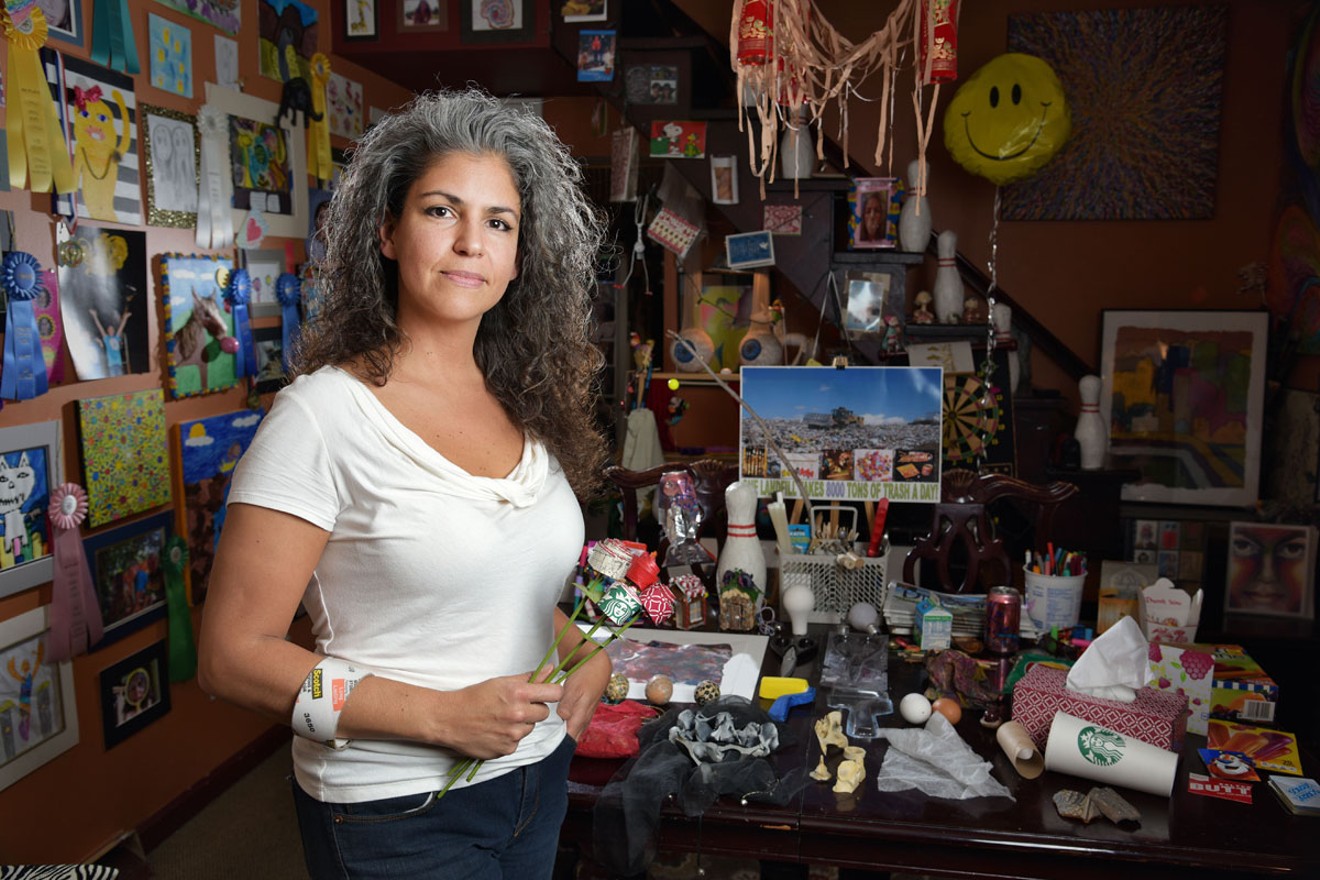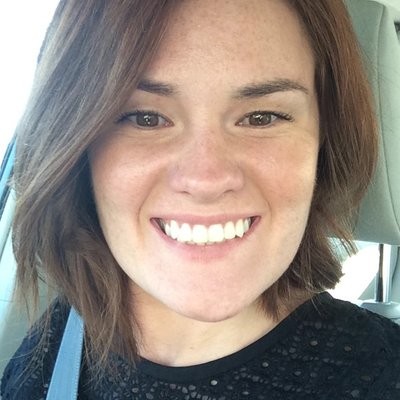“When we’re done with this conversation, I’m going to look like a big bum,” says Teresa Castaneda, laughing as she stands by the front door of her home on Elati Street. She’s petite and tan, and a shock of gray curly hair frames her face like a wave.
It takes a few minutes to adjust to the decor in her home, so much adorns what’s essentially a few office cubicles crammed under one roof. But then symmetry appears. Large and small jars filled with dead, luminescent-green flies and the guts of ancient TV sets are lined up in grids on shelves. Brushes and paint are stacked according to height. Half of the dining room table is covered with empty Chinese takeout containers, plastic packaging for scissors and assorted trash organized like a puzzle; the other half holds what appear to be small art projects.
A second glance reveals that the art is made from trash, too. A brilliant koi fish hanging from a miniature fishing pole is actually a LaCroix sparkling water can affixed with tin-foil fins. “When you have a birthday, you get one of these,” Castaneda says, pointing to bright, cheery greeting cards that were made from Ritz crackers boxes.
For the past ten years, Castaneda has hosted ReArranging Denver workshops. She visits libraries and schools — most of them in low-income communities — and teaches children how to make art from their own trash. She’ll ask the kids to bring empty chip bags or milk cartons, which they’ll eventually turn into something sparkly to hang on trees or miniature houses.
Sometimes when she takes ReArranging Denver to wealthier neighborhoods, students will finish class and ask if she can give them more trash for projects. “I look at them and say, ‘Don’t you have trash at home?’ And they say, ‘Oh, yeah.’”
Bringing in their own “supplies” helps the kids “realize that they are part of impacting art,” Castaneda says. The fish on her dining-room table came from a project in which children made dozens of koi and hung them by their classroom door. “Whenever you opened the door, all the fish would wiggle,” she says. “Your impact on other people was one of the lessons. The other lesson was about your impact on Earth.”
Castaneda insists that she’s not trying to save the world. But in her own small way, she is: She makes people feel connected to their waste instead of just mindlessly dumping it. If people can see trash for what it is — another piece of litter sullying the planet — maybe they’ll throw less away. Maybe they’ll even turn it into art.
When Castaneda was a little girl, she would accompany her grandfather to landfills around Denver while he scrapped for metal and other materials. “I remember the feeling of walking up these soft mountains and seeing the trash under my feet,” she says. “It impacted me so much. I can’t forget the feel of it.” Now every time she showcases her art — her sculptures and photographs have been shown in the Denver Art Museum and at the Denver County Fair — and at every ReArranging Denver workshop, she displays a blown-up picture of a landfill with the words “8,000 tons of trash goes into a single landfill a day.”
Her passion for conservation and art merged much later in life; it took Castenada years to even realize she was an artist. “I went to Catholic school, and I saw stuff all the time,” she says. “Teachers would grab me, and I would come out of what I was seeing. I honestly thought something was wrong with me because I saw art all the time — sleeping, eating, awake.” In high school, she was finally exposed to painting and jewelry-making classes and remembers thinking, “‘Oh, that’s what it is.’ There’s nothing wrong with seeing stuff every day.”
“Now, my frustration is trying to get it done [because] there are so many ideas,” she says. “My brain is like a gymnasium filled with children, all with extended arms going, ‘Pick me!’ And I can’t get to all of them.”
Castaneda’s father was a classically trained oil painter, and all of her art teachers at what today is Metropolitan State University of Denver were purists. “You don’t go back to mess with a photo,” she says of her tutelage. “You do it, and that’s it.” But life taught Castaneda to embrace the mess. She was homeless for a year, which she says undoubtedly made her reconsider waste, and then she had two children. “Having kids has really changed how I do art,” she explains. “You have to do it quickly, think faster, use other resources.”
Castaneda definitely connects with children. More important, they connect with her — maybe because they, too, see a can of soda not just as a drink container, but as a potentially glimmering piece of treasure. Castaneda’s worldview is even a little contagious for adults. As she talks, she holds a stack of CDs in her hand. Perhaps a future art project? Something to hang off string and let dangle in the sun?
She laughs. “Actually, this is just some music I want to play.”
This story is part of a series on spring cleaning, which will be rolling out all week ahead of Earth Day on Saturday, April 22. Don't miss part one, a story about Clarke the recycling robot, and part two, about Denver's disappearing dumpsters; also catch our video of Teresa Castaneda.
[
{
"name": "Air - MediumRectangle - Inline Content - Mobile Display Size",
"component": "12017618",
"insertPoint": "2",
"requiredCountToDisplay": "2"
},{
"name": "Editor Picks",
"component": "17242653",
"insertPoint": "4",
"requiredCountToDisplay": "1"
},{
"name": "Inline Links",
"component": "18838239",
"insertPoint": "8th",
"startingPoint": 8,
"requiredCountToDisplay": "7",
"maxInsertions": 25
},{
"name": "Air - MediumRectangle - Combo - Inline Content",
"component": "17261320",
"insertPoint": "8th",
"startingPoint": 8,
"requiredCountToDisplay": "7",
"maxInsertions": 25
},{
"name": "Inline Links",
"component": "18838239",
"insertPoint": "8th",
"startingPoint": 12,
"requiredCountToDisplay": "11",
"maxInsertions": 25
},{
"name": "Air - Leaderboard Tower - Combo - Inline Content",
"component": "17261321",
"insertPoint": "8th",
"startingPoint": 12,
"requiredCountToDisplay": "11",
"maxInsertions": 25
}
]












